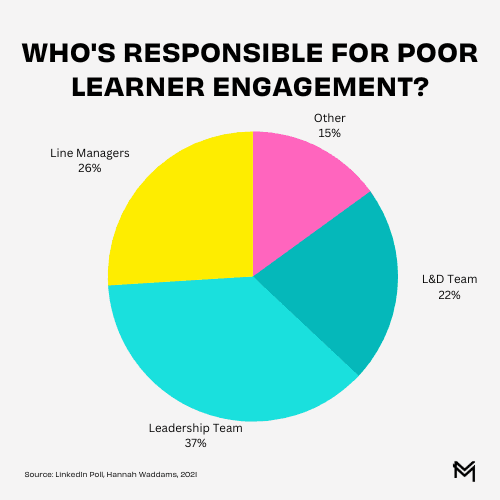want some cookies?
We use cookies to make your browsing experience amazing.

According to a poll I ran on LinkedIn, 78% of people do not think learner engagement is L&D’s responsibility. And that blows my mind.
Learner engagement is always a hot topic in our industry. Everybody is quick to share their top tips, tricks and hacks of boosting it - but the conversation rumbles on year after year. And perhaps this poll is a clear indication of why: If L&D aren’t willing to take responsibility for learner engagement; who will? And if nobody takes responsibility for it, will it ever improve?

I’ll be honest with you, the LinkedIn poll came from a place of desperation. I often hear phrases like “line-managers don’t give people time to learn” and “the senior leadership team doesn't prioritise learning - so there’s no learning culture here”. And it’s these phrases that stop L&D taking responsibility for the crisis at hand. So I put this poll up in the hope I’d just encountered a bunch of L&D cynics, and that industry-wide perception was different. But regrettably, that wasn’t the case.
The importance of learning culture
The term ‘learning culture’ is used a lot in the L&D industry. Just like ‘learner engagement’, everybody has a bag full of tricks to create a sparkling learning culture - but almost no organisation seems to have one. Learning culture is defined as:
“...a collection of organisational conventions, values, practices and processes. These conventions encourage employees and organisations to develop knowledge and competence.” - Tala A. Nabong, 360training.com
This can be roughly translated as ‘organisations giving their people the time, space and permission to learn’. And yes, that needs to come from the top. The senior leaders in your organisation must embrace learning, and understand that learning can drive business growth. Your organisational culture has a huge impact on learner engagement. In fact, Sirsendu Das, a learning solutions architect, provided a great example of culture’s impact on learner engagement:
Consider the Army for a second. Nobody enrols to become a soldier without full awareness of how they must act. Training is never considered optional, or a ‘nice to have’. There are no gimmicks or engagement tactics to get junior soldiers interested in training. Instead, it's an integral part of the culture in the Army; and the culture itself takes care of learner engagement.
Of course, the stakes are likely to be much higher for a soldier than they are for our learners. But the principle remains the same. Our people need to be highly skilled and proficient at their jobs in order to make the most impact, and the only way to become highly skilled and proficient is learning. This acceptance of learning should be embraced company-wide and baked into your culture. And the single best way to ensure this is by your senior managers setting an example.
Leaders must set an example to ensure learner engagement.
But what if they aren’t leading by example? What if they aren’t embracing learning opportunities - or worst still, what if they’re bad mouthing them? In this situation learning professionals often shrug their shoulders and give up trying. But that shouldn’t be the case.
If your leaders aren’t engaged with learning and development, it almost certainly comes from a place of misunderstanding. All business leaders want one thing: for their business to be prosperous and achieve the best it possibly can. As learning professionals we know the impact learning can have on the bottom line, but do your senior managers realise this potential? Do they understand that by implementing a learning programme about smart working practices that you’ll boost company productivity? Do they know that by reducing the number of health and safety incidents in the workplace you’ll decrease spend? Perhaps not. And it’s your responsibility to educate them on all these topics and more.
Learners need time, space and security to learn
Once your senior managers begin to embrace learning, you’ll see a shift in perceptions trickle down your organisation. But often line-managers are a blocker; and therefore are in the firing line of L&D’s blame game.
Learning something new can make your employees feel vulnerable. Often they’re worried about the fear of failure, or the time they’ll have to dedicate to learning. And the only way to overcome this is by line-managers offering both time and psychological safety for people to complete the learning at hand.
But line-managers unsurprisingly prioritise the day job and the operational aspects of an organisation. They want their teams to work smarter and be more efficient. And they do not see how corporate learning can help with this. Instead, they see it as a waste of time. This is for one reason: line-managers don’t understand what they (or their employees) will get from the learning you are offering them. And they’re worried about how their managers will react if employees take time out to learn, and aren’t high on output or productivity. They’d rather their people focus on operational training and learning on the job. It’s this fear cycle that inhibits learning on the job, and it’s L&D’s responsibility to shift perceptions and educate line-managers on the ‘what’s in it for me?’ (WIIFM).
Developing self-directed learners
There are often arguments in the world of L&D about the learner’s responsibility when it comes to learning. And it’s frequently used in defence of both senior leaders and line-managers. If employees were passionate about learning; the organisation would facilitate it. But they don’t ask - so they don’t get. And this is where the phrase “self-directed learners” seems to crop up.
Self-directed learning is defined as learners who “take charge of their own learning process (diagnosing learning needs, identify learning goals, select learning strategies, and evaluate learning performances and outcomes)”.
I’m sure we all agree this is a huge responsibility to place on a learner's shoulders - especially when they’re keeping up with their day job alongside it. So what happens when we do this? Your employees don’t prioritise learning - and your business misses out on the myriad of benefits that come with corporate learning.
The truth is, we can’t expect too much of our employees when it comes to learning. They don’t care, and that’s absolutely OK.
Of course we want motivated and driven employees in our organisation. But their primary goal as an employee is to complete their day job to the best of their ability. And this sometimes means that seeking out learning opportunities falls to the bottom of their priority list. So, unless you encourage learning, it won’t happen.
But as well as facilitating learning, L&D must also market their learning effectively. Marketing learning is often harder than marketing a product or service. Instead of asking people to sacrifice money, you’re asking them to sacrifice something much more precious - their time. And considering 1 in 8 workers in the UK work more than 48 hours a week - which is between 8 and 11 hours longer than most people are contracted to work - it’s safe to say your target audience, aka your learners, are super busy.
Because of their hectic schedules and desperately trying to maintain a work-life balance, your learners will not take responsibility for learning if they do not understand what’s in it for them. What will they get from embarking on the upcoming learning programme or training day? What is the opportunity cost of spending time learning vs. doing their day job? There is only one team responsible for answering that question - and yep, you guessed it - it’s the L&D team.
No matter which way you cut it… the buck lies with L&D
No matter the excuses you make, or how many times you blame others, there is only one team that is judged on the effectiveness of learning. And there is only department solely responsible for learner engagement - and that’s L&D. Of course, for true learner engagement, and for the development of a learning culture, you must have buy-in from everybody mentioned above. But the only way to ensure that is by L&D standing up and taking responsibility once and for all.
Don Taylor, Chair at Learning Technologies Conference, joined the debate on LinkedIn - and summarised the matter so succinctly: “Why is it L&D's responsibility? Because we are the professionals. If we are (for example) brought late into the implementation of a new platform, and told to train people on it, we should only do so after certain criteria are met: sufficient budget, top-level support, guaranteed time from managers, whatever is needed. As I say, we are the professionals. We know what it takes to produce an engaging learning programme, and should fight for it.”
You wouldn’t blame the finance team for poor marketing. Nor would you blame a customer for receiving a bad haircut. So why do L&D blame other divisions of our organisation, or the learners themselves, for poor learner engagement? Leadership and line managers are our peers and colleagues, and the learners are our customers.
Instead of passing the buck, it’s time L&D stood up and held themselves accountable.
As Teemu Lilja summarised so nicely in his comment on LinkedIn: “Shared responsibility usually ends up in no responsibility.”
It is our job as learning professionals to educate everybody on the impact learning can have on the wider organisation. And yes - that may mean spending some time ‘managing up’, and educating senior leaders. It may mean spending time discussing the ‘what’s in it for me?’ with line-managers. It may even mean you have to run learning campaigns and create a hype around your learning, to get learners engaged. But whatever needs to be done - it’s the L&D team’s responsibility to do it - and boost learner engagement once and for all.










